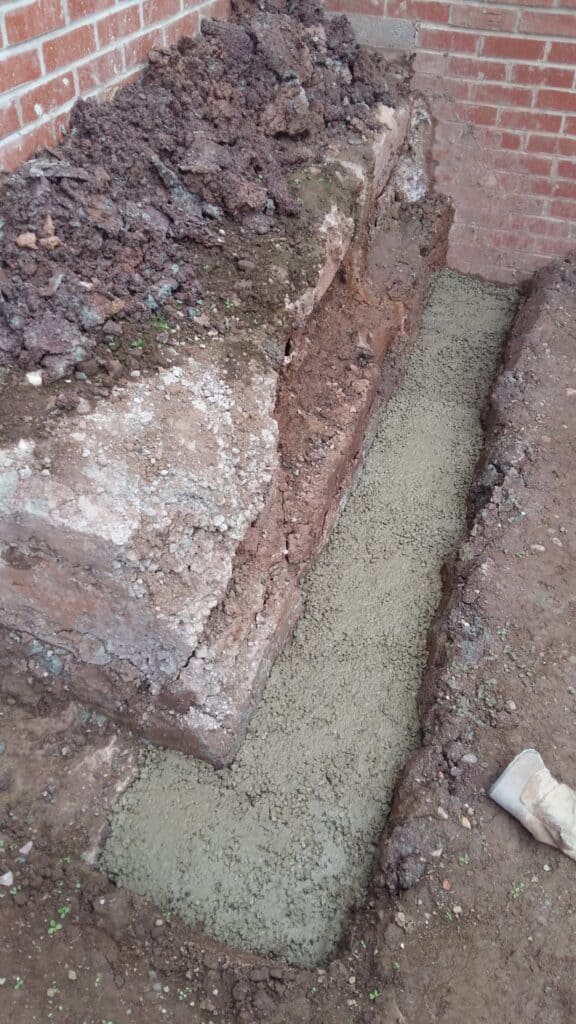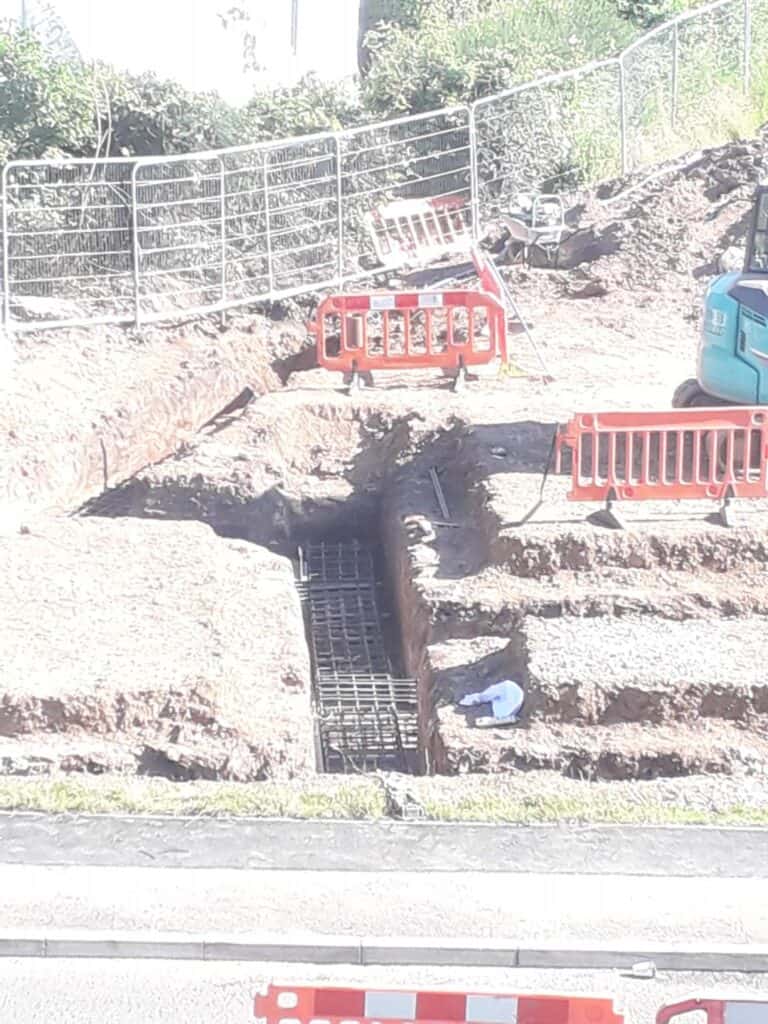When you start pouring concrete and building projects, you will face many challenges, with many people not always being sure why rebar may even be needed. The use of rebar can be highly confusing when you are still learning how to use concrete and build projects.
Rebar is not always needed when working with concrete, with many concrete do-it-yourself projects not requiring the strength provided by rebar. However, if the concrete will support a lot of weight or be used structurally, rebar will be required to strengthen the concrete.
Many people use the depth of the concrete to know when and how to use the rebar when building with concrete. We always recommend understanding why rebar has to be used and how it affects the concrete before building structures requiring more strength.
What Concrete Does Not Need Rebar?

Generally speaking, if you are making flat slabs of concrete on the ground and no more than four to five inches thick, you do not need rebar. The natural strength of the concrete will be able to withstand the pressures that are going to be applied to it, with the ground helping to keep it together.
However, if you are making thicker slabs or concrete that needs to stand upright, you will have to put a rebar in the concrete to protect it. If the concrete is thicker than five inches, the chances are higher that it can be too brittle or be so light that it floats out of the ground.
Generally, when laying flat sheets of concrete, you need to ensure that the concrete slab does not float when it rains because it is acting like a boat in the mud. We have seen many DIY projects where the concrete has been poured too thick, crumbling, or floating up when the first rains start.
What Does Rebar Add To Concrete?

Concrete adds tensile strength, combining with the concrete to make a much stronger composite material that easily handles much more than normal concrete. Normal concrete is solid against compressive strength but usually fails when pulled or twisted.
The rebar quickly helps the concrete withstand these pressures when applied, in the same way an alloy material would distribute the pressure. Concrete with rebar is a (relatively) new approach with entirely new structural strengths than just concrete poured and dried.
Rebar has been one of the great ways that concrete can be strengthened, instead of just being a mixture that can be used for flat slabs. When appropriately used, rebar will allow you to build almost anything from concrete while ensuring it is strong enough to handle almost anything.
How Long Does Concrete Last Without Rebar?
Depending on the type of rebar you are using, how well the concrete is sealed, and how much moisture is introduced, reinforced concrete may only last under one hundred years. Usually, the rebar will rust long before the concrete itself has started becoming weaker.
Concrete on its own has been used in structures for thousands of years, with many of the most ancient structures using concrete to hold everything together. However, modern construction uses concrete in a completely different manner than the ancients did.
While there are still many structures that only have one or two floors built with concrete and stones or bricks, the vast majority of structures use reinforced concrete. As the rebar naturally starts to rust inside the concrete, it expands, breaking down the concrete from the inside out.
What Happens If You Don’t Use Rebar?
Without rebar, concrete becomes extremely weak to tension forces; these would be forces that pull and twist the concrete. As the concrete flexes, it forms cracks; with rebar in the structure, the cracks can move throughout the entire piece of concrete.
As the concrete becomes thicker and harder, it becomes much easier to destroy or damage when there is no rebar inside. An excellent way to think about concrete structure is to imagine a sponge that can compress with ease and handle the pressure as needed; however, it fails when twisted or pulled.
The rebar inside concrete prevents the entire structure of the concrete from moving when tensile strengths are being applied. At the same time, stopping any cracks from traveling throughout the length of a concrete slab, helping the concrete withstand pressures that it would previously have failed at.
Does A Floor Need Rebar?

If you are creating a floor that is only four inches thick and will only ever have to support people and furniture, you may not need rebar. However, if the floor will be used as a machining shop, handle vehicles, or a lot of foot traffic, it needs to have rebar inside to strengthen it.
Further, the concrete needs to be reinforced when poured outside as a driveway, ensuring that it will not bend, flex, and crack when cars drive on it. This is often why people that have DIYed their driveways have driveways that are not flat, have several cracks, and low-quality driveways.
We have often seen people forget that concrete, even when ten inches thick, can not easily handle the weight of vehicles or workshop machines. Often creating weaker floors than just a normally poured four- or five-inch-thick concrete because of the cracks that start to form.
Can You Pour Concrete On Dirt?
Yes, you can pour concrete over dirt; however, you will need to prepare the area thoroughly before doing so. Ensure that concrete is properly anchored, that the dirt is not too loose, and that there are channels for water flow around the slab before pouring everything.
Most concrete is poured directly onto dirt, with the dirt being prepared thoroughly before doing so, unlike what many people may think. You cannot simply pour concrete on a patch of land that has no plants on it; the concrete will not stay in the shape you need it and will eventually crack.
Instead, digging a hole, watering everything down, compacting the dirt, and building a frame in the shape you want is needed. Doing so will have the concrete be in the precise shape that you need it to be while being strong enough to weather any storm, weight, or vehicle.
What Size Should The Rebar Be In Concrete?

Rebar is measured differently than other materials that you may use in projects, being divided into their category. Usually, rebar comes in sizes from one to five, with the numbering on them telling you where the rebar has to be used and how it should be used for your projects.
Number 3 rebar is meant for driveways and patios, number four is for walls and columns, while number 5 is meant for footers and foundations. As the number of the rebar increases, its size will become much larger, with number one rebar being bendable by hand and number five being almost too heavy to pick up.
Most proper projects will use a combination of rebar to ensure that larger and thicker parts of concrete have the support it needs. Other areas of the thinner concrete require that the rebar that you are using is also thinner to ensure that the concrete is not more steel than cement.
How Can You Strengthen Concrete Without Rebar?
If you need your concrete to be strong without using rebar, you can use a steel wire mesh system or create smaller slabs of concrete. Many people that want to build their driveways or footpaths can build four- to five-inch-thick slabs that are not all one giant piece.
This prevents cracks from being created at one corner of the walkway and then spreading throughout the entire walkway or driveway. The concrete path can also bend to the sand and elements without breaking or cracking entirely with the individual slabs.
However, it should be noted that when using individual concrete blocks, you will have to do yearly maintenance of rebalancing everything. Ensuring that the concrete stays safe and crack-free simply because it is not twisted whenever someone steps on it.
Conclusion
Concrete needs rebar to be as strong as possible; however, if poured thin enough and used only for walking, you can quickly go without rebar. We always recommend that you have a system in place to strengthen the concrete, though, to ensure the best results.
Whatever you do, please don’t pour a gigantic slab of concrete with no rebar in it!
